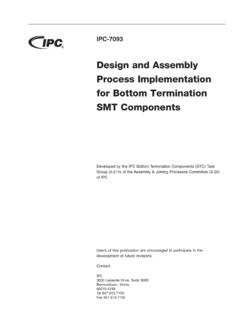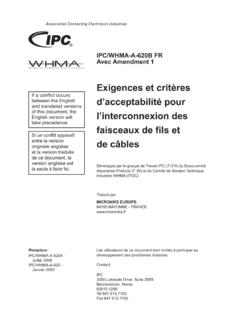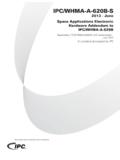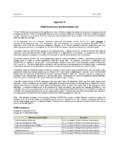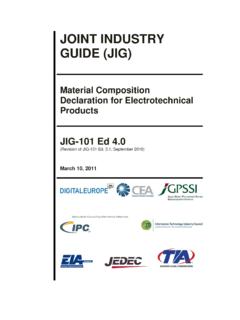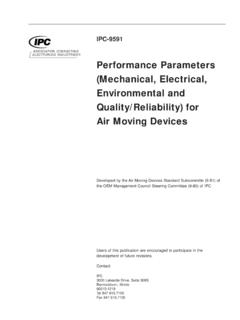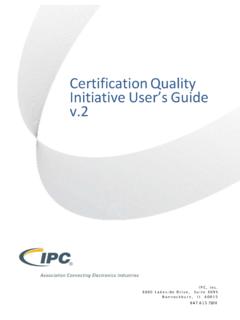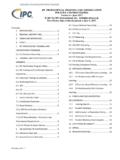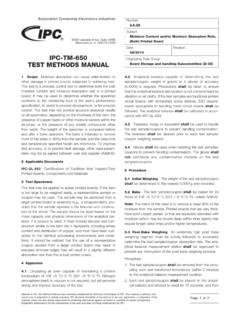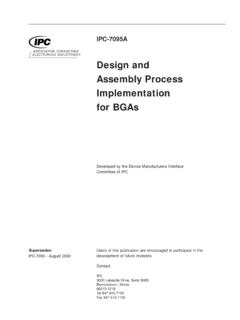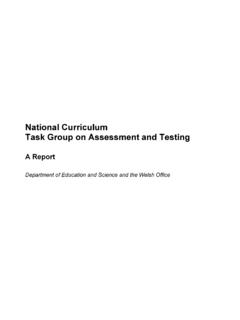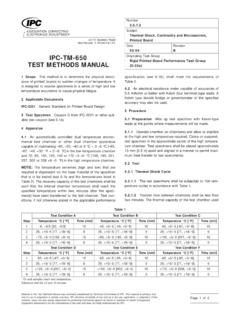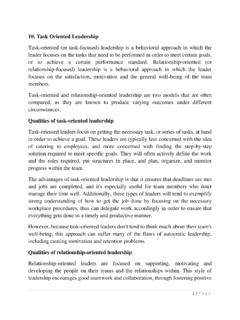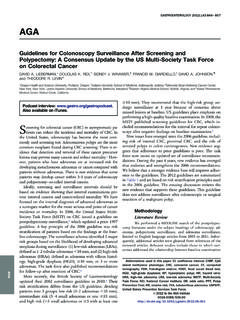Transcription of IPC-TM-650 Originating Task Group TEST METHODS MANUAL
1 1 PurposeThese tests are used as process controltools, they can be used to inspect printed wiring boards orprinted wiring assemblies and determine if they conform to themonitoring level of the user s performance specification. Bulkionic cleanliness testing may be accomplished by measuringthe ionizable surface contaminants extracted by the followingthree METHODS :1. MANUAL extraction method2. Dynamic extraction method3. Static extraction RestrictionsMeasurements of ionic conductivities donot differentiate between different ionic species. They simplymeasure conductivities (or resistivities) which can be related toamounts of ionic materials present in solution. There is noidentification of the contribution to the total conductivity read-ings of any individual ionic species which may be present inthe solution.
2 For measurement of individual ionic species (typeand level of residue) see IPC-TM-650 , Test Method ,Ionic Analysis of Circuit Boards, Ion Chromatography simplicity, amounts of ionic materials in solution can beexpressed by a conductivity factor which is equivalent to themeasured conductivity contributed by a known amount of astandard strongly ionized salt such as sodium chloride (NaCl).Ionic residues are therefore usually expressed as equivalentsof sodium chloride in micrograms per unit surface area ( gNaCl ) of the sample. This does not imply that thecontamination is NaCl but, rather, it exhibits a conductivityfunction which is equivalent to that of the expressed amountof sodium chloride if it were in solution instead of the ionic tests will not measure any surface ionic materials whichare not brought into solution because of insolubility, physicalentrapment or inadequate exposure to the extracting , non-ionic components of the soil will not be ApplicationCaution should be exercised in comparingresults between different test equipment as well as the differ-ent test METHODS .
3 These METHODS are applicable as qualitycontrol tools in evaluating the parameters of materials andcleaning process, in terms of how they affect the final cleanli-ness of the board or assembly. As process control tools, theycan be used to inspect printed wiring boards or printed wiringassemblies and determine if they conform to the requirementsof the user s performance specification. It is important tounderstand, no calculation factor can exist to convert datafrom one style of commercial tester to another due to thegreat differences in system responses. See IPC-TR-583. Thismeans it is very difficult to compare data from procedures can also be used to assist in-processdevelopment as general residue indicators, to evaluate fluxcleanability, solvent efficiency and general improvements ofprocess Applicable DocumentsIPC-TR-583 (EMPF RR00013)An In-Depth Look at IonicCleanliness Testing, August 19933 Test SpecimenFollow the equipment manufacturer srecommendations as to sample size.
4 Recommended area cal-culations for the unpopulated and assembled boards are thefollowing:Length x Widthx2=Unpopulated Board Surface Area(Length x Width x 2) + up to 50% = Assembled Board SurfaceArea4 MANUAL Extraction DescriptionThis method manually extracts ionic mate-rial from the suface of a sample. This consists of flushing thesurface with a stream of 2-propanol/water mixture and care-fully catching all of the drippings before measuring the resis-tivity of the composite Test Equipment and laboratory ware ( , beakers, funnels,storage bottles and graduated cylinders). This plastic warecan be high density polyethylene, polymethylpentene (poly-pentene) or equivalent. Glassware cannot be used because ithas been shown to contribute ionic contamination in a shorttime with this solvent/water Sanders RoadNorthbrook, IL 60062-6135 IPC-TM-650 TEST METHODS and Measurement of Ionizable SurfaceContaminants by Resistivity of Solvent Extract(ROSE)Date2/01 RevisionCOriginating Task GroupIonic Conductivity Task Group (5-32a)Material in this Test METHODS MANUAL was voluntarily established by Technical Committees of IPC.
5 This material is advisory onlyand its use or adaptation is entirely voluntary. IPC disclaims all liability of any kind as to the use, application, or adaptation of thismaterial. Users are also wholly responsible for protecting themselves against all claims or liabilities for patent referenced is for the convenience of the user and does not imply endorsement by CONNECTINGELECTRONICS INDUSTRIES bridge and liquid conductivity cell appa-ratus capable of measuring specific resistances within a rangecovering at least 100 k -cm to 20 M column. Barnstead HN Ultrapure MixedBed or :Some of these columns are color dyed. This dye willinterfere with test results. Make certain that the column usedhas no Electronic Grade 2-Propanol (isopropyl alcohol) Deionized water (DI water)Above 1 M -cmwater resistivityNote:It is critical to always use wash solution with the samecomposition of electronic grade 2-propanol/DI water for allcomparative data solution composed of 75 2% v/v 2-propanol/DI water or 50 2% v/v 2-propanol/DI water.
6 This wash solu-tion must be deionized to a resistance equal to or greater than6M -cm (conductivity less than S/cm). If stored, thiswash solution must be freshly deionized prior to use. Typicalresistivity of 25 M -cm (conductivity of S /cm) can beachieved. Calibration of the alcohol water solution should beperformed using a calibrated default extract solution composition is 75 2% v/v2-propanol/DI Calibration of BridgeThis is essential in the manualmethod because there can be no correlation betweenresistivity/conductivity readings and NaCl equivalents withoutcalibration. All future specification requirements are to bestated in maximum micrograms of NaCl equivalent per squarecentimeter ( g NaCl ). or purchase (these standard solutions areavailable from equipment vendors, as well as many of thechemical companies) a standard NaCl solution from a weightof ACS reagent grade NaCl salt dissolved in deionized water(16 M -cm resistivity minimum) to produce a final diluted con-centration of g/liter NaCl (5 mL equals 300 g NaCl).
7 Note:It is recommended that dry NaCl be used for this solu-tion. A recommended drying exposure is one hour at 50 one liter of the 2-propanol/DI water solution (atthe calibration temperature of the bridge in use) in a :The 75 % v/v or 50 % v/v 2-propanol/DI water solutionmust be used in this calibration. Water cannot be used sinceit is not the test solution used in the procedure. The test solu-tion used in this calibration can be recleaned by passingthrough the deionization column until the required resistivity/conductivity is a 50 mL burette, add to the liter of test solution,5 mL of the standard g/liter NaCl solution. Stir and mea-sure resistivity a 50 mL burette, add to the liter of test solution,20 additional mL of the standard g/liter NaCl solution, fora total of 25 mL.
8 Stir and measure resistivity a 50 mL burette, add to the liter of test solution,25 additional mL of the standard g/liter NaCl solution, fora total of 50 mL. Stir and measure resistivity a three-point nomogram of Conductivity vs g/liter of NaCl. You should get a linear relationship and youshould use a piecewise linear best fit line through the a multi-range meter is used the curve should not beextended beyond the maximum reading of the meter for thatrange, unless linearity is proven by additional points obtainedby adding more standard salt solution. The nomogram willnever cross the zero point of Test preclean all plastic ware with deionized water(16 M -cm resistivity minimum) followed by a final rinse withthe 2-propanol test the surface area of the printed wiring boardor assembly, including both sides.
9 Subtract an estimatedvalue for any cut-out section of the board. Recommendedarea calculations for the unpopulated and assembled boardsare the following:Length x Widthx2=Unpopulated Board Surface Area(Length x Width x 2) + up to 50% = Assembled Board and Measurement of Ionizable Surface Contaminantsby Resistivity of Solvent Extract (ROSE)Date2 the test specimen within a convenient sizedfunnel positioned over a graduated cylinder. Care must betaken not to handle the sample or any of the appliances usedto hold the sample with bare a fine stream of freshly-deionized test solutionon both sides of the specimen, covering all board and com-ponent surfaces. Continue this process, slowly collecting allthe runoff in the graduated cylinder until a minimum volumehas been collected.
10 Use a general ratio of no more than 10mL:1cm2of area. The volume collected is not critical, butthe total volume must be exactly recorded. A volume correc-tion is made in the the final measured volume into a plastic warebeaker, stir and measure the resistivity/conductivity with thebridge resistivity/conductivity readings can be used toconvert the g NaCl equivalent. as follows:1. Locate where the resistivity or conductivity intersects thecalibration curve on the X-axis (see Figure 1).2. Extend a vertical line from the point of intersection to thex-axis. Read and record g/liter NaCl (M).3. Multiply the concentration in g/liter NaCl by the total litersof test solution used (V). This result indicates the total g ofNaCl equivalents removed from the printed wiring board(T).
